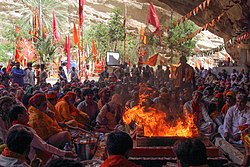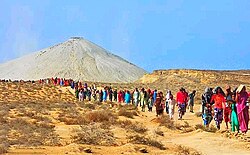Hinduism in Balochistan
 Hawan at Shri Hinglaj Mata temple. | |
| Total population | |
|---|---|
| 49,133 (2017) 0.4% of total Balochistan population | |
| Religions | |
| Hinduism (majority) and other Baloch tribes (minority) | |
| Scriptures | |
| Bhagavad Gita, and Vedas | |
| Languages | |
| Sanskrit (sacred) Balochi (majority) Urdu and other languages (minority) |
Hinduism is a minority religion in Balochistan followed by 0.4% of the population of the province. It is the largest minority religion in Balochistan. The Balochistan is home to the shrine of Shri Hinglaj Mata temple, which is one of the most sacred Hindu temples.[1][2] The annual Hinglaj Yatra to the temple is the largest Hindu pilgrimage in Pakistan.[3]
History
The earliest people in Balochistan were the Brahui people, a Dravidian speaking people closely related to the Dravidian speaking people of South India. They were originally Hindus and Buddhists.[4] The Hindu Sewa Dynasty ruled much of region of Balochistan up until the 7th century AD. The Sibi division which was carved out of the Quetta division still derives its name from Rani Sewi, the queen of the Hindu Sewa dynasty.[5] In 634 CE, the Hindu Brahman dynasty of Sindh controlled parts of Balochistan.[6]
During the 7th century, Arab forces invaded Balochistan subsequently converting a large majority of the Baloch people from Hinduism to Islam.[7]
"Proverbially elastic though the term is, Hinduism is stretched almost to breaking point in Baluchistan. It is not merely that the Hinduism of the domiciled Hindu families widely different from the Hinduism they see practised among the alien immigrants; there is precious little in their religion that would pass for Hinduism in more enlightened parts of India. It almost looks as if the singular freedom from persecution which the old Hindu families have always enjoyed at the hands of their Musalman over-lords had given Islam greater scope to impart its subtle influence to their inward beliefs and outward practices. Knowing no sacred books but the Sikh scriptures, and with priests (Brahmans though they may be) as ignorant of the Shastras as themselves, these benighted Hindus have allowed nearly all their rites and ceremonies to become coloured with an Islamic tinge." [8]: 57
— Excerpt from the Census of India, 1911 AD
After the partition of British India and the ensuing creation of Pakistan, much of the Hindu Baloch migrated to India,[9] particularly the Bhagnaris community. [10][11]
Demographics
According to the 1998 Census, Balochistan had approximately 39,000 Hindus (including the Scheduled Castes) constituting 0.59% of the population.[12] In the 2017 Census, the absolute number of Hindus increased to 49,000 but their percentage decreased to 0.4%.[13] However, Pakistan Hindu Council estimates that there are 117,345 Hindus in Balochistan.[14]
| Population (1911)[8]: 57 | Percentage (1911) |
|---|---|
| 38,326 | 4.59% |
| Population (1941)[15]: 18 | Percentage (1941) |
|---|---|
| 54,394 | 6.34% |
| Population (1998)[12] | Percentage (1998) |
|---|---|
| 39,000 | 0.59% |
| Population (2017)[13] | Percentage (2017) |
|---|---|
| 49,133 | 0.40% |
Community life
Only a minority of Baloch people are Hindus.[16] There are Hindu Balochs in the Bugti, Bezenjo, Marri, Rind and other Baloch tribes.[17]
Compared to the rest of the country, the Hindus in Balochistan province are relatively more secure and face less religious persecution. The tribal chiefs in Balochistan, particularly the Jams of Lasbela and Bugti of Dera Bugti, consider non-Muslims including Hindus as members of their own extended family and allows religious freedom. They have never forced Hindus to convert. In Balochistan Hindu places of worship are proportionate to their population. For example, between Uthal and Bela jurisdiction in Lasbela District, there are 18 temples for 5,000 Hindus living in the area, which is an indicator of religious freedom.[18] However, in Khuzdar District and Kalat District, Hindus face discrimination.[19]
The Hindu marriages in Punjab are registered under the Hindu marriage act of 2017.[20][21] In Balochistan provincial assembly, there are three seats reserved for minorities. Hindus usually get elected on 1 or 2 seats.[22][23]
Temples
Hawan at Hinglaj Mata mandir
Baba Chandragup is an important stop during Hinglaj Yatra
See also
- Hinduism in Pakistan
- Punjabi Hindus
- Hinduism in Punjab, Pakistan
- Hinduism in Sindh Province
- Hinduism in Khyber Pakhtunkhwa
References
- ^ Schaflechner, Jürgen (2018). Hinglaj Devi : identity, change, and solidification at a Hindu temple in Pakistan. New York, NY: Oxford University Press. pp. 66. ISBN 9780190850555. OCLC 1008771979.
The worship of the Hinglaj Mata in Balochistan has been one of the most important tourist and religious pilgrimage for the Hindus of Pakistan and the trends has place in history from Medieval India.
- ^ Being in the World Productions (2011), OnBecoming Gods, Pakistan, event occurs at 44 min, retrieved 2018-08-07
- ^ "In a Muslim-majority country, a Hindu goddess lives on". Culture & History. 10 January 2019. Retrieved 24 May 2021.
- ^ Dictionary of Languages: The Definitive Reference to More Than 400 Languages. Columbia University Press. 2004. ISBN 9780231115698. Retrieved 24 May 2021.
- ^ The tribal Baluchistan by Syed Abdul Quddus page 49
- ^ Skutsch, Carl, ed. (2005). Encyclopedia of the World's Minorities. New York: Routledge. p. 178. ISBN 1-57958-468-3.
- ^ Dashti, Naseer (2012). The Baloch and Balochistan: A Historical Account from the Beginning to the Fall of the Baloch State. Trafford Publishing. pp. 63–67.
- ^ a b "CENSUS OF INDIA, 1911 VOLUME IV BALUCHISTAN" (PDF). Retrieved 23 September 2021.
- ^ Banerjee-Dube, Ishita; Dube, Saurabh (2009). Ancient to modern: religion, power, and community in India. New Delhi; Oxford: Oxford University Press. ISBN 978-0-19-569662-2. OCLC 302183130.
- ^ Roshni Nair (3 December 2016). "Mumbai's filmi daredevils with a cross-border history". Hindustan Times. Retrieved 24 May 2021.
- ^ Sadaf Modak (7 November 2016). "A piece of Balochistan in Mumbai since Partition — 150 families & Khatti Dal". Retrieved 24 May 2021.
- ^ a b "Population Distribution by Religion, 1998 Census" (PDF). Pakistan Bureau of Statistics. Archived (PDF) from the original on 26 December 2016. Retrieved 24 May 2021.
- ^ a b "SALIENT FEATURES OF FINAL RESULTS CENSUS-2017" (PDF). Retrieved 24 May 2021.
- ^ "Hindu Population (PK) – Pakistan Hindu Council". Archived from the original on 15 March 2018. Retrieved 24 May 2021.
{{cite web}}: CS1 maint: unfit URL (link) - ^ "CENSUS OF INDIA, 1941 VOLUME XIV BALUCHISTAN". Retrieved 23 September 2021.
- ^ Kamal Siddiqi (30 July 2009). "Hingol Temple Symbolises Baloch Secularism". Hindustan Times. Retrieved 24 May 2021.
- ^ "Over 100 Hindu Families In Pak Want To Migrate To India". Hindustan Times. 3 January 2011. Retrieved 24 May 2021.
- ^ Tarar, Akhlaq Ullah (31 March 2019), "Forced conversions", Dawn, retrieved 24 May 2021
- ^ Javaid, Maham (18 August 2016), "State of fear", Herald (Pakistan), retrieved 24 May 2021
- ^ "Pakistan Senate passes landmark Hindu marriage bill". The Hindu. 18 February 2017. Retrieved 24 May 2021.
- ^ Kalbe Ali (27 September 2016). "NA finally passes Hindu marriage bill". Dawn. Retrieved 24 May 2021.
- ^ Aqeel, Asif (1 July 2018), "Problems with the electoral representation of non-Muslims", Herald (Pakistan), retrieved 21 May 2021
- ^ "General Elections 2018 - Reserved Seats Returned Candidates Notifications - National Assembly and Provincial Assemblies". Election Commission of Pakistan. Retrieved 24 May 2021.



